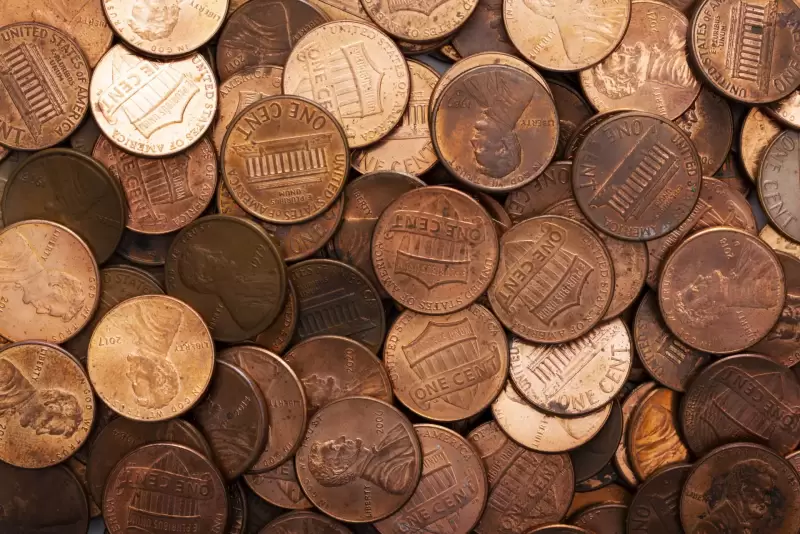 |
|
 |
|
 |
|
 |
|
 |
|
 |
|
 |
|
 |
|
 |
|
 |
|
 |
|
 |
|
 |
|
 |
|
 |
|
Cryptocurrency News Articles
President Donald Trump Calls to Stop Minting New Pennies, Citing Rising Production Costs
Apr 21, 2025 at 09:23 am
VICTORVILLE, Calif. (VVNG.com) — President Donald Trump has called for the U.S. Treasury to stop minting new pennies, citing the coin's rising production costs and

President Donald Trump has called for a pause on U.S. Treasury’s production of pennies, citing the coin’s rising costs and calling the continued manufacturing “wasteful.”
“For far too long the United States has been making pennies which cost us more than 2 cents. Unbelievable. We’re continuing to mint pennies at a huge loss. This is so wasteful! I have instructed my Secretary of the US Treasury to stop producing new pennies,” Trump wrote in a Truth Social post on Thursday.
While the president can direct the Treasury to pause production, eliminating a U.S. coin entirely still requires Congressional approval—a step that has failed to advance in previous attempts.
It Now Costs 3.69 Cents to Make A Penny
According to the U.S. Mint’s most recent report, it cost 3.69 cents to produce a single penny in fiscal year 2024—more than triple the coin’s face value. This marks the 19th consecutive year that pennies have been made at a financial loss.
The increase is largely tied to the rising cost of materials, particularly copper. Although pennies are mostly made of zinc, they are coated in copper, and copper prices rose by over five percent last year.
The nickel is also being produced at a loss, with each five-cent coin costing nearly 14 cents to mint. Other coins continue to be profitable:
These figures were confirmed in a February 2025 article published by NBC/Nexstar, which examined the cost breakdown of circulating U.S. coins.
How It Could Affect Local Businesses
If penny production slows or stops, businesses across the Victor Valley could begin rounding cash transactions to the nearest five cents.
For example, a bill totaling $4.97 might be rounded up to $5.00, or $4.92 might be rounded down to $4.90. This change would only apply to cash transactions, while card payments would remain exact.
For many local businesses—especially small restaurants, food vendors, and retail shops where cash is still widely used—this could mean:
Customers who rely on cash, including unbanked residents, may feel the impact more directly. According to the FDIC, an estimated 5.6 million households in the U.S. remain unbanked and continue to rely on coins and physical currency.
Rounding practices may also affect the total cost of goods, depending on how businesses implement the change. Some may choose to round in the customer’s favor to maintain goodwill, while others may round up to simplify cash handling.
Why The Penny Still Exists
Despite its production cost, the penny remains in circulation for several reasons.
Former U.S. Mint officials have explained that while the Mint loses money on the penny and nickel, it profits on other coins, such as quarters and dollar coins, which helps offset the losses.
There is also lobbying pressure from industries that supply the metals used in pennies, particularly zinc. Additionally, prior legislative efforts to reform coin production have failed to pass. In both 2020 and 2023, bipartisan bills aimed at reducing minting costs stalled in Congress.
“Even though you’re losing $80 million a year on one single product line, $80 million is a pittance compared to a $4 trillion budget,” former U.S. Mint Director Ed Moy told NBC4.
What Comes Next
While President Trump’s directive has brought renewed attention to the future of the penny, the U.S. Mint continues to produce them.
Any permanent decision would require Congressional legislation—something experts agree is unlikely to happen quickly.
Disclaimer:info@kdj.com
The information provided is not trading advice. kdj.com does not assume any responsibility for any investments made based on the information provided in this article. Cryptocurrencies are highly volatile and it is highly recommended that you invest with caution after thorough research!
If you believe that the content used on this website infringes your copyright, please contact us immediately (info@kdj.com) and we will delete it promptly.
-

- Remittix (RTX) Price Prediction: Can the Meme Coin Rally Again?
- Apr 22, 2025 at 09:25 pm
- The SHIB price forecast for 2x gains in 2025 has generated renewed interest among investors. However, as Shiba Inu struggles to regain traction, a new altcoin named Remittix (RTX) is being touted as the actual breakout sensation—one capable of taking an investment of $1000 to $100,000.
-

-

-

-

- With the project raising an impressive $69 million of its $73 million target
- Apr 22, 2025 at 09:15 pm
- With the project raising an impressive $69 million of its $73 million target during its presale phase, early investors are watching closely to see if this meme coin can maintain its momentum into 2025.
-

-

-

-





























































